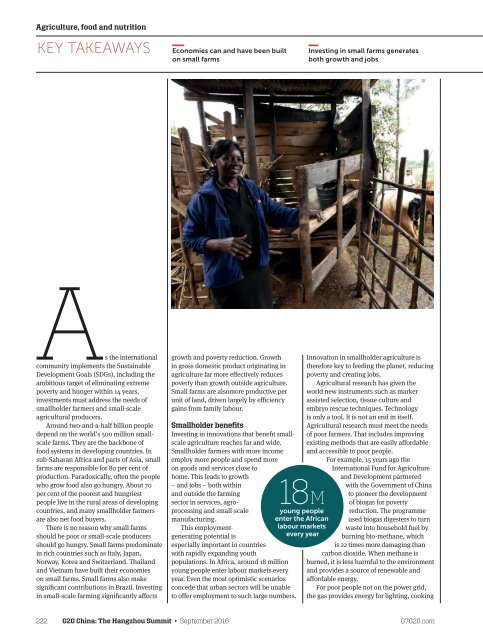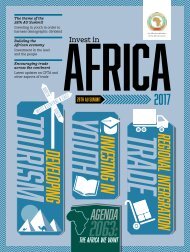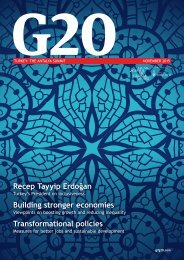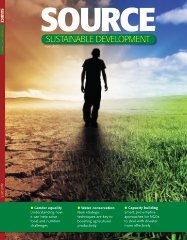G20 china_web
Create successful ePaper yourself
Turn your PDF publications into a flip-book with our unique Google optimized e-Paper software.
Agriculture, food and nutrition<br />
KEY TAKEAWAYS<br />
Economies can and have been built<br />
on small farms<br />
Investing in small farms generates<br />
both growth and jobs<br />
As the international<br />
community implements the Sustainable<br />
Development Goals (SDGs), including the<br />
ambitious target of eliminating extreme<br />
poverty and hunger within 14 years,<br />
investments must address the needs of<br />
smallholder farmers and small-scale<br />
agricultural producers.<br />
Around two-and-a-half billion people<br />
depend on the world’s 500 million smallscale<br />
farms. They are the backbone of<br />
food systems in developing countries. In<br />
sub-Saharan Africa and parts of Asia, small<br />
farms are responsible for 80 per cent of<br />
production. Paradoxically, often the people<br />
who grow food also go hungry. About 70<br />
per cent of the poorest and hungriest<br />
people live in the rural areas of developing<br />
countries, and many smallholder farmers<br />
are also net food buyers.<br />
There is no reason why small farms<br />
should be poor or small-scale producers<br />
should go hungry. Small farms predominate<br />
in rich countries such as Italy, Japan,<br />
Norway, Korea and Switzerland. Thailand<br />
and Vietnam have built their economies<br />
on small farms. Small farms also make<br />
significant contributions in Brazil. Investing<br />
in small-scale farming significantly affects<br />
growth and poverty reduction. Growth<br />
in gross domestic product originating in<br />
agriculture far more effectively reduces<br />
poverty than growth outside agriculture.<br />
Small farms are alsomore productive per<br />
unit of land, driven largely by efficiency<br />
gains from family labour.<br />
Smallholder benefits<br />
Investing in innovations that benefit smallscale<br />
agriculture reaches far and wide.<br />
Smallholder farmers with more income<br />
employ more people and spend more<br />
on goods and services close to<br />
home. This leads to growth<br />
– and jobs – both within<br />
and outside the farming<br />
sector in services, agroprocessing<br />
and small-scale<br />
manufacturing.<br />
This employmentgenerating<br />
potential is<br />
especially important in countries<br />
with rapidly expanding youth<br />
populations. In Africa, around 18 million<br />
young people enter labour markets every<br />
year. Even the most optimistic scenarios<br />
concede that urban sectors will be unable<br />
to offer employment to such large numbers.<br />
18M<br />
young people<br />
enter the African<br />
labour markets<br />
every year<br />
Innovation in smallholder agriculture is<br />
therefore key to feeding the planet, reducing<br />
poverty and creating jobs.<br />
Agricultural research has given the<br />
world new instruments such as marker<br />
assisted selection, tissue culture and<br />
embryo rescue techniques. Technology<br />
is only a tool. It is not an end in itself.<br />
Agricultural research must meet the needs<br />
of poor farmers. That includes improving<br />
existing methods that are easily affordable<br />
and accessible to poor people.<br />
For example, 15 years ago the<br />
International Fund for Agriculture<br />
and Development partnered<br />
with the Government of China<br />
to pioneer the development<br />
of biogas for poverty<br />
reduction. The programme<br />
used biogas digesters to turn<br />
waste into household fuel by<br />
burning bio-methane, which<br />
is 22 times more damaging than<br />
carbon dioxide. When methane is<br />
burned, it is less harmful to the environment<br />
and provides a source of renewable and<br />
affordable energy.<br />
For poor people not on the power grid,<br />
the gas provides energy for lighting, cooking<br />
222 <strong>G20</strong> China: The Hangzhou Summit • September 2016 G7<strong>G20</strong>.com
















